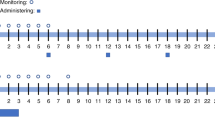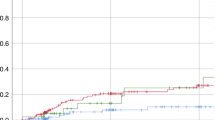Abstract
The purpose of this study was to evaluate the influence of busulfan (BU) pharmacokinetics on survival, grades II–IV acute graft-versus-host disease (GVHD), non-relapse mortality (NRM) and relapse in a group composed of 45 children (<18 years) and seven adults with acute myeloid leukemia (aml) in first complete remission and undergoing hematopoietic stem cell transplantation (sct). fifty-two patients underwent autologous (n = 25) or allogeneic (n = 27) SCT. The median age was 8.9 years (range 0.6–53 years). Conditioning therapy consisted of BU and cyclophosphamide. Improved disease-free survival was found in those patients with a steady-state concentration of BU (CssBU) below the median (<578 mg/ml, P = 0.05), and the same trend was noted for overall survival (P = 0.07). This was secondary to a higher incidence of NRM in the group of patients with CssBU above the median (P = 0.06). There was no significant correlation with CssBU and relapse (P = 0.31). No association between CssBU and GVHD was found in allogeneic patients (P = 0.30). Relapse was evaluated among the subgroups of age (< or >10 years) and transplant type (allogeneic or autologous) with no statistically significant association observed among these factors. Multiple regression analysis for relapse revealed no significant correlation with CssBU above or below the median, age, or transplant type. In this study, CssBU below the median did not correlate with an inferior outcome for patients with AML. Pharmacokinetic dosing of BU may be important for prevention of NRM but does not appear to influence the risk of relapse in this largely pediatric population with AML. Bone Marrow Transplantation (2000) 26, 607–614.
This is a preview of subscription content, access via your institution
Access options
Subscribe to this journal
Receive 12 print issues and online access
$259.00 per year
only $21.58 per issue
Buy this article
- Purchase on Springer Link
- Instant access to full article PDF
Prices may be subject to local taxes which are calculated during checkout



Similar content being viewed by others
References
Blazar BR, Ramsay NK, Kersey JH et al. Pretransplant conditioning with busulfan (Myleran) and cyclophosphamide for nonmalignant diseases. Assessment of engraftment following histocompatible allogeneic bone marrow transplantation Transplantation 1985 39: 597–603
Parkman R, Rappeport JM, Hellman S et al. Busulfan and total body irradiation as antihematopoietic stem cell agents in the preparation of patients with congenital bone marrow disorders for allogenic bone marrow transplantation Blood 1984 64: 852–857
Lucarelli G, Polchi P, Galimberti M et al. Marrow transplantation for thalassaemia following busulphan and cyclophosphamide Lancet 1985 1: 1355–1357
Hassan M, Ehrsson H, Ljungman P . Aspects concerning busulfan pharmacokinetics and bioavailability Leuk Lymphoma 1996 22: 395–407
Vassal G, Gouyette A, Hartmann O et al. Pharmacokinetics of high-dose busulfan in children Cancer Chemother Pharmacol 1989 24: 386–390
Hassan M, Oberg G, Bekassy AN et al. Pharmacokinetics of high-dose busulphan in relation to age and chronopharmacology Cancer Chemother Pharmacol 1991 28: 130–134
Grochow LB, Krivit W, Whitley CB et al. Busulfan disposition in children Blood 1990 75: 1723–1727
Vassal G, Fischer A, Challine D et al. Busulfan disposition below the age of three: alteration in children with lysosomal storage disease Blood 1993 82: 1030–1034
Vassal G, Challine D, Koscielny S et al. Chronopharmacology of high-dose busulfan in children Cancer Res 1993 53: 1534–1537
Buggia I, Zecca M, Alessandrino EP et al. Itraconazole can increase systemic exposure to busulfan in patients given bone marrow transplantation. GITMO (Gruppo Italiano Trapianto di Midollo Osseo) Anticancer Res 1996 16: 2083–2088
Hassan M, Fasth A, Gerritsen B et al. Busulphan kinetics and limited sampling model in children with leukemia and inherited disorders Bone Marrow Transplant 1996 18: 843–850
Buggia I, Locatelli F, Regazzi MB et al. Busulfan Ann Pharmacother 1994 28: 1055–1062
Hassan M, Oberg G, Bjorkholm M et al. Influence of prophylactic anticonvulsant therapy on high-dose busulphan kinetics Cancer Chemother Pharmacol 1993 33: 181–186
Regazzi MB, Locatelli F, Buggia I et al. Disposition of high-dose busulfan in pediatric patients undergoing bone marrow transplantation Clin Pharmacol Ther 1993 54: 45–52
Hassan M, Ljungman P, Bolme P et al. Busulfan bioavailability Blood 1994 84: 2144–2150
Vassal G, Deroussent A, Challine D et al. Is 600 mg/m2 the appropriate dosage of busulfan in children undergoing bone marrow transplantation? Blood 1992 79: 2475–2479
Yeager AM, Wagner JE Jr, Graham ML et al. Optimization of busulfan dosage in children undergoing bone marrow transplantation: a pharmacokinetic study of dose escalation Blood 1992 80: 2425–2428
Poonkuzhali B, Srivastava A, Quernin MH et al. Pharmacokinetics of oral busulphan in children with beta thalassaemia major undergoing allogeneic bone marrow transplantation Bone Marrow Transplant 1999 24: 5–11
Santos GW, Tutschka PJ, Brookmeyer R et al. Marrow transplantation for acute nonlymphocytic leukemia after treatment with busulfan and cyclophosphamide New Engl J Med 1983 309: 1347–1353
Tutschka PJ, Santos GW . Bone marrow transplantation in the busulfin-treated rat. III. Relationship between myelosuppression and immunosuppression for conditioning bone marrow recipients Transplantation 1977 24: 52–62
Chattergoon DS, Saunders EF, Klein J et al. An improved limited sampling method for individualised busulphan dosing in bone marrow transplantation in children Bone Marrow Transplant 1997 20: 347–354
Demirer T, Buckner CD, Appelbaum FR et al. Busulfan, cyclophosphamide and fractionated total body irradiation for allogeneic marrow transplantation in advanced acute and chronic myelogenous leukemia: phase I dose escalation of busulfan based on targeted plasma levels Bone Marrow Transplant 1996 17: 341–346
Slattery JT, Sanders JE, Buckner CD et al. Graft-rejection and toxicity following bone marrow transplantation in relation to busulfan pharmacokinetics (published erratum appears in Bone Marrow Transplant 1996; 18:829) Bone Marrow Transplant 1995 16: 31–42
Slattery JT, Clift RA, Buckner CD et al. Marrow transplantation for chronic myeloid leukemia: the influence of plasma busulfan levels on the outcome of transplantation Blood 1997 89: 3055–3060
Dix SP, Wingard JR, Mullins RE et al. Association of busulfan area under the curve with veno-occlusive disease following BMT Bone Marrow Transplant 1996 17: 225–230
Grochow LB, Jones RJ, Brundrett RB et al. Pharmacokinetics of busulfan: correlation with veno-occlusive disease in patients undergoing bone marrow transplantation Cancer Chemother Pharmacol 1989 25: 55–61
Ljungman P, Hassan M, Bekassy AN et al. High busulfan concentrations are associated with increased transplant-related mortality in allogeneic bone marrow transplant patients Bone Marrow Transplant 1997 20: 909–913
Vassal G, Deroussent A, Hartmann O et al. Dose-dependent neurotoxicity of high-dose busulfan in children: a clinical and pharmacological study Cancer Res 1990 50: 6203–6207
Deeg HJ, Storb R . Graft-versus-host disease: pathophysiological and clinical aspects Annu Rev Med 1984 35: 11–24
Weisdorf DJ, Snover DC, Haake R et al. Acute upper gastrointestinal graft-versus-host disease: clinical significance and response to immunosuppressive therapy Blood 1990 76: 624–629
Pawlowska AB, Blazar BR, Angelucci E et al. Relationship of plasma pharmacokinetics of high-dose oral busulfan to the outcome of allogeneic bone marrow transplantation in children with thalassemia Bone Marrow Transplant 1997 20: 915–920
Kaplan EL, Meier P . Nonparametric estimation from incomplete observations J Am Stat Assoc 1958 53: 457–481
Cox DR . Regression models and life-tables J R Stat Soc 1972 34: 187–202
Davies SM, Ramsay NK, Klein JP et al. Comparison of preparative regimens in transplants for children with acute lymphoblastic leukemia J Clin Oncol 2000 18: 340–347
Shankar SM, Bunin NJ, Moshang T Jr . Growth in children undergoing bone marrow transplantation after busulfan and cyclophosphamide conditioning J Pediatr Hematol Oncol 1996 18: 362–366
Michel G, Socie G, Gebhard F et al. Late effects of allogeneic bone marrow transplantation for children with acute myeloblastic leukemia in first complete remission: the impact of conditioning regimen without total-body irradiation – a report from the Société Française de Greffe de Moelle J Clin Oncol 1997 15: 2238–2246
Adan L, de Lanversin ML, Thalassinos C et al. Growth after bone marrow transplantation in young children conditioned with chemotherapy alone Bone Marrow Transplant 1997 19: 253–256
Vaughan WP, Cagnoni P, Fernandez H et al. Decreased incidence of and risk factor for hepatic veno-occlusive disease with an intravenous busulfan (BU) containing preparative regimen for hematopoietic stem cell transplantation (HSCT) Blood 1998 92: 516a
Andersson BS, Cagnoni P, Jones R et al. Allogeneic hemopoietic stem cell transplantation (BMT) after IV busulfan, and cyclophosphamide (BuCy) for acute myeloid leukemia (AML) and myelodysplasia (MDS) Blood 1999 94: 167a
Kashyap A, Wingard J, Cagnoni P et al. Intravenous (IV) vs. oral busulfan (BU) as part of a BU/CY (cyclophosphamide) preparative regimen for allogeneic hematopoietic stem cell transplantation (HSCT): decreased incidence of hepatic veno-occlusive disease (VOD) Blood 1999 94: 321b
Acknowledgements
This work was supported in part by the Children's Cancer Research Fund, Minneapolis, MN.
Author information
Authors and Affiliations
Rights and permissions
About this article
Cite this article
Baker, K., Bostrom, B., DeFor, T. et al. Busulfan pharmacokinetics do not predict relapse in acute myeloid leukemia. Bone Marrow Transplant 26, 607–614 (2000). https://doi.org/10.1038/sj.bmt.1702590
Received:
Accepted:
Published:
Issue Date:
DOI: https://doi.org/10.1038/sj.bmt.1702590
Keywords
This article is cited by
-
Hematopoietic stem cell transplantation for children with acute myeloid leukemia—results of the AML SCT-BFM 2007 trial
Leukemia (2020)
-
Optimizing drug therapy in pediatric SCT: Focus on pharmacokinetics
Bone Marrow Transplantation (2015)
-
Busulphan given as four single daily doses of 150 mg/m2 is safe and effective in children of all ages
Bone Marrow Transplantation (2004)
-
Autologous stem cell transplantation in hematological malignancies
Springer Seminars in Immunopathology (2004)
-
Intravenous busulfan for allogeneic hematopoietic stem cell transplantation in infants: clinical and pharmacokinetic results
Bone Marrow Transplantation (2003)



